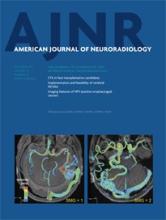Abstract
BACKGROUND AND PURPOSE: The risk of hemorrhage in the context of developmental venous anomaly is considered to be very low, but it has never been evaluated by susceptibility-weighted MR imaging at 3T. The goal of the present study was to evaluate the prevalence of hypointense foci (ie, microhemorrhage or cavernous malformation) associated with DVA on phase-sensitive MR imaging, on the basis of principles similar to those of susceptibility-weighted MR imaging, and to evaluate the relationship between the hypointense foci and several factors, such as white matter hyperintense lesions adjacent to DVA on T2-weighted imaging, DVA morphology, and clinical symptoms.
MATERIALS AND METHODS: This study retrospectively evaluated 61 lesions in 59 consecutive patients with DVA who underwent MR imaging including phase-sensitive MR imaging. Two neuroradiologists independently assessed for the presence of hypointense foci and other factors such as DVA location, depth, size, direction of draining vein on phase-sensitive MR imaging, and white matter hyperintense lesion on T2-weighted imaging. Clinical symptoms were also assessed.
RESULTS: Hypointense foci were observed in 62.3% (38/61) of lesions. White matter hyperintense lesion was more frequently observed in patients with hypointense foci (26/38) than in patients without hypointense foci (7/23) (P < .01). There was no significant association between hypointense foci and other factors.
CONCLUSIONS: Our results support the hypothesis that microhemorrhage or cavernous malformation can be related to venous congestion caused by abnormal venous drainage. We conclude that phase-sensitive MR imagingis useful for the detection of microhemorrhage or cavernous malformation in patients with DVA, especially when associated with white matter hyperintense lesion.
ABBREVIATIONS:
- CM
- cavernous malformation
- DVA
- developmental venous anomaly
- ICH
- intracranial hemorrhage
- PSI
- phase-sensitive MR imaging
- WMH
- white matter hyperintense lesion
- © 2013 by American Journal of Neuroradiology












